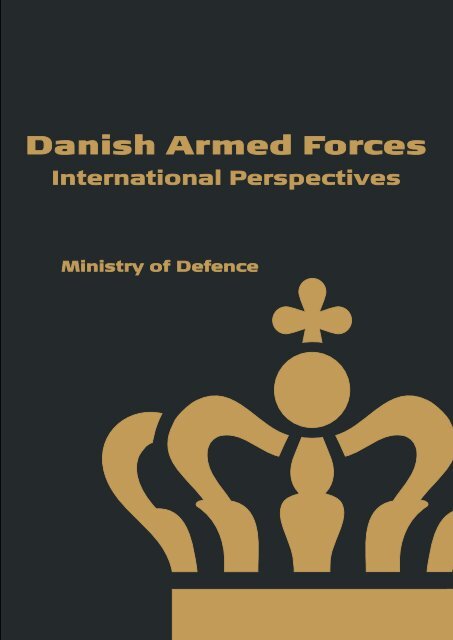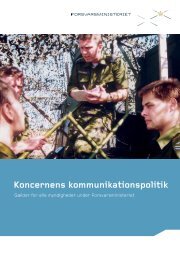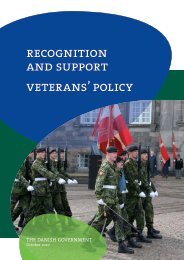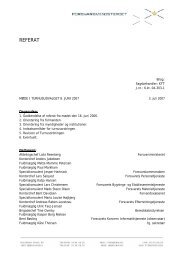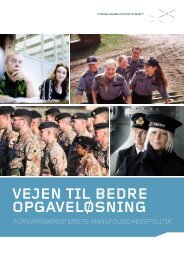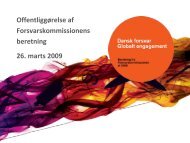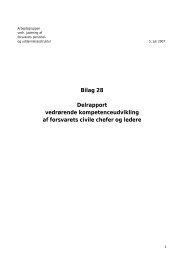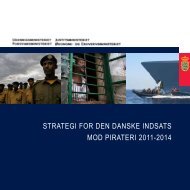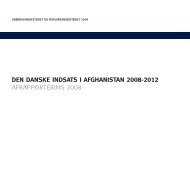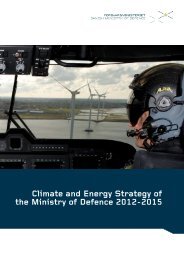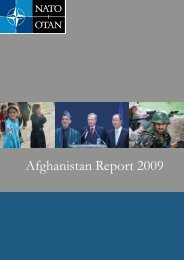Danish Armed Forces: International Perspectives
Danish Armed Forces: International Perspectives
Danish Armed Forces: International Perspectives
- No tags were found...
You also want an ePaper? Increase the reach of your titles
YUMPU automatically turns print PDFs into web optimized ePapers that Google loves.
ForewordThe overall goal for the <strong>Danish</strong> <strong>Armed</strong> <strong>Forces</strong> continues to b e the preservation ofDenmark as a sovereign nation. Defence policy oft odayis, however, not onlyaq uestionofd efending national territor ies. Modern defence policy has toreflect a numberofd ifferentc onsiderations.<strong>International</strong> engagement is central to a successful handling of the security problemsand challengeso f the future. <strong>Danish</strong> security and defence policy is thereforevery much characterised and influenced byd evelopments ont he international scene– and Denmark is extensively engaged in both international military crisis managementoperations and civil emergency missions all over the world. Today, the fightagainst terrorism is one oft he main challenges for the <strong>Danish</strong> <strong>Armed</strong> <strong>Forces</strong>.With the <strong>Danish</strong> Defence Agreement agreed in 2004c overing the years 2005-2009,Denmark is doubling its ambition with regards to the number of <strong>Danish</strong> troopsthat can bec ontinuously deployed. The ambition is by2 009 tob e able tom aintaindeployed approximately2 ,000t roops orfors horter periods bea ble tod eploy largerforce levels. When this number is compared tot he size oft he <strong>Danish</strong> population(5.3 million), Denmark is among one oft he leading countries in the world whenit comes to participation in international operations. Another important aspect ofthe Defence Agreement is, that a broad majority oft he <strong>Danish</strong> Parliament is behindthe agreement. This gives an optimal foundation for the future development oft he<strong>Danish</strong> <strong>Armed</strong> <strong>Forces</strong>.In this booklet you will find a general introduction tot he <strong>Danish</strong> <strong>Armed</strong> <strong>Forces</strong>w itha focus ono ur engagements in international activities. I hopet hat you will find thebooklet interesting and informative, and that after reading it, you will have a goodunderstanding ofw hat are the priorities for the <strong>Danish</strong> <strong>Armed</strong> <strong>Forces</strong>.Søren GadeMinister ofD efence, DenmarkPhoto: Christian Alsing.<strong>Danish</strong> <strong>Armed</strong> <strong>Forces</strong>: <strong>International</strong> <strong>Perspectives</strong>3
Photo: <strong>Danish</strong> <strong>Armed</strong> <strong>Forces</strong>.Photo: Royal <strong>Danish</strong> Air Force PhotoS ervice.4 <strong>Danish</strong> <strong>Armed</strong> <strong>Forces</strong>: <strong>International</strong> <strong>Perspectives</strong>
<strong>Danish</strong> <strong>Armed</strong> <strong>Forces</strong>:<strong>International</strong> <strong>Perspectives</strong><strong>Armed</strong> <strong>Forces</strong> as aForeign Policy Instrument . ............................. 6Achanging World -<strong>Armed</strong> <strong>Forces</strong> in change ................................8<strong>Danish</strong> Participation in<strong>International</strong> Military Crisis Management Operations .......10The <strong>International</strong> Capacity of the <strong>Danish</strong> Emergency Management Agency ........13Total Defence ....................................................16Cooperation between Military and Civilian Efforts ..........................17The United Nations ...............................................18<strong>Danish</strong> Policy in NATO ..............................................19European Security and Defence Policy (ESDP) .............................21The Organisation for Security and Co-operation inEurope (OSCE) ..............22<strong>International</strong> Security Cooperation .....................................23Equipment and Acquisition . .........................................25The <strong>Danish</strong> Army 2004 .............................................29The <strong>Danish</strong> Navy . ................................................30The <strong>Danish</strong> Air Force ...............................................32The <strong>Danish</strong> Home Guard . ...........................................33The <strong>Danish</strong> Emergency Management Agency .............................34The Intelligence Service’s Support for <strong>International</strong> Operations ................36The <strong>Danish</strong> Administration ofNavigation and Hydrography . ..................37The <strong>Danish</strong> Defence Budget. .........................................38Do you want toknow more? .........................................40<strong>Danish</strong> <strong>Armed</strong> <strong>Forces</strong>: <strong>International</strong> <strong>Perspectives</strong>5
<strong>Armed</strong> <strong>Forces</strong> as aForeign PolicyInstrumentThe <strong>Danish</strong> <strong>Armed</strong> <strong>Forces</strong> is an important instrument inensuring peacea nd security both in Denmark and internationally.The currents ecurity policy situation is characterised byt helack ofac onventional threat tot he <strong>Danish</strong> territoryin theforeseeable future. Thus, there is no longer a need for thetraditional territorial defence which has been mounted tocounteract such a threat.The terrorist attacks of1 1September 2001 and subsequentterrorist attacks in Europe and other places demonstratethat the security policy challenges and risks confrontingDenmark and other nations have significantly changed.New asymmetric and unpredictable threats, such as internationalterrorism and the spreading of weapons of massdestruction and their means of delivery, have entered thescene.The threats do not have too riginatefrom Denmark’s geographicalproximity, but may constitute a risk to Denmark,our allies and our common values, even if they manifestthemselves further away. Accordingly, the priority ofsecurity policy should be aimed at p ossessing the capabilityto counter the threats where they emerge, regardlessof whether this is within or beyond Denmark’s borders.Therefore, <strong>Danish</strong> <strong>Armed</strong> <strong>Forces</strong>-t ogether with other nationalinstitutions - focus ons trengthening the total defenceofD enmark and its population and one nsuring Denmark’scapability top articipatein international operations.Did you know that?NATOis the cornerstone ofD anish security policy,but OSCE and increasingly EU are also relevantforums for <strong>Danish</strong> security policy. The overall frameworkfor <strong>Danish</strong> security is based upon the UnitedNations.Photo: <strong>Danish</strong> <strong>Armed</strong> <strong>Forces</strong>TV and Media Centre.6 <strong>Danish</strong> <strong>Armed</strong> <strong>Forces</strong>: <strong>International</strong> <strong>Perspectives</strong>
<strong>Danish</strong> <strong>Armed</strong> <strong>Forces</strong>: <strong>International</strong> <strong>Perspectives</strong>7
Achanging World -<strong>Armed</strong> <strong>Forces</strong> inchangeThere is a tradition in Denmark for long-term defence agreements. This means that the budget isagreed uponforap eriod ofu p to5y ears. The defence agreements are normally supported byab roadmajority in the Parliament which give the agreements a degree ofrobustness in case ofc hanginggovernments. The newest defence agreement was agreed on 10 June 2004 and covers the years2005-2009.Overall the development ofD anish security policy requirest hat the <strong>Armed</strong> <strong>Forces</strong>strengthen theircapabilities in two central areas:• <strong>International</strong>ly deployable military capabilities• Total Defence, including the ability toc ounter terrorist acts and perform consequencemanagement.The ambition for the <strong>Armed</strong> <strong>Forces</strong>is tom obilise and deploy forcesp romptly and flexibly in internationaloperations and to maintain deployed capacities equaling up to 2,000 personnel (1,500 from theArmy and 500 fromt he Navy and Air Force).The conscription has been reorganised and targeted onTotal Defence. Att he same time, it will formthe basis ofrecruitment intot he <strong>Armed</strong> <strong>Forces</strong>a nd contributet o anchoring the <strong>Armed</strong> <strong>Forces</strong>in the<strong>Danish</strong> society.The personnel composition is to b e continuously adapted. The <strong>Armed</strong> <strong>Forces</strong>’ full-time equivalentsare to be reduced from approximately 2 9,000 ( 6,500 of which are full-time conscript equivalents)at the end of 2 004 to approximately 2 6,400 full-time equivalents (2,450 of which will be full-timeconscripte quivalents) byt he end of2 009. The personnel composition, etc., will beindicated in theannual appropriation act.Reserve personnel will continue tob e ofg reats ignificance for the <strong>Armed</strong> <strong>Forces</strong>in relation tointernationalmissions as well as tot he training ofm ilitary units and Total Defence.A separate political agreement was entered into by all political parties in the Folketing on 2 1June2002 for emergency management. This four-year agreement outlines the development oft he area,specifying focus, aims and concrete projects.8 <strong>Danish</strong> <strong>Armed</strong> <strong>Forces</strong>: <strong>International</strong> <strong>Perspectives</strong>Photo: Warrant Officer I Per A.R asmussen, Defence Information and Welfare Service.
<strong>Danish</strong> <strong>Armed</strong> <strong>Forces</strong>: <strong>International</strong> <strong>Perspectives</strong>9
<strong>Danish</strong> Participation in <strong>International</strong>Military Crisis Management OperationsThe <strong>Danish</strong> constitution requiresa pproval oft he <strong>Danish</strong> Parliament (Folketinget) beforeD anish forcesare deployed tointernational operations where the use offorceis an option toa ccomplish themission.Deployment oft he <strong>Armed</strong> <strong>Forces</strong>t o international military operations continues tob e one oft he principaltasks ofD anish Defence Policy.United Nations<strong>Danish</strong> soldiers have been involved in large-scale peacekeeping operations for the United Nationsonan umber ofo ccasions. During the decades after World War II Denmark had larger contingents ofpersonnel in Congo, Gaza, and Cyprus.After the collapse of Yugoslavia, <strong>Danish</strong> forces were involved in the United Nations peacekeepingoperations in both Croatia and Bosnia-Herzegovina. A significant symbol of the <strong>Danish</strong> participationin Bosnia-Herzegovina was the presence ofL eopard tanks, which were the heaviestw eapon ofUNPROFOR ground troops.Under the auspiceso f the United Nations Stand-by High Readiness Brigade (SHIRBRIG) Denmark alsodeployed in 2000/2001 a peacekeeping force to Ethiopia and Eritrea after hostilities between thetwo countries ceased.Since 1948 Denmark has had observers in moret han 20U nited Nations observer missions. The observermissions are characterized byb eing carried out byn ormally unarmed military personnel whoseprimary tasks are typically too bserve and oversee cease-fire agreements.NATOo perationsAfter the Daytonp eacea greement was reached, Denmark contributed with contingents tot he NATOImplementation Force (IFOR) – later the Stabilisation Force (SFOR) – in Bosnia-Herzegovina. The newforce had a morerobust mandatet han its United Nations predecessor. Denmark is also contributinga significant number offorces tot he NATOforcein Kosovo (KFOR). The force was deployed in 1999after NATOa ircrafts – including <strong>Danish</strong> F-16 fighters –c arried out a 72 day air campaign against theFormer Republic ofYugoslavia.Did you know that?• Since the end ofW orld War II Denmark has contributed with moret han 50,000 soldiers,sailors and airmen to international operations under the auspices oft heU nited Nations,NATOa ndc oalitions oft hew illing.• <strong>Danish</strong> military observers serve in areas as different from Denmark as Damascus and theHimalaya Mountains• The United Nations Peacekeeping <strong>Forces</strong> was awarded the Nobel Peace Price in 1988.10 <strong>Danish</strong> <strong>Armed</strong> <strong>Forces</strong>: <strong>International</strong> <strong>Perspectives</strong>
Photo: <strong>Danish</strong> <strong>Armed</strong> <strong>Forces</strong>.<strong>Danish</strong> naval vessels were also involved in maritime operations in the Adriatic Sea during the Yugoslavwars. Following the terrorist attacks onU SA on1 1September 2001 <strong>Danish</strong> vessels have been involvedin NATOo perations in the Mediterranean in order top articipatein the fight against global terrorism(Operation Active Endeavour).Since the ousting of the Taliban regime from Afghanistan, Denmark has contributed to the<strong>International</strong> Security Assistance Force (ISAF) which in 2003 was taken over byN ATO. Originally themandateo f the force was limited toK abul, but in parallel with the improved security situation in thecountry,N ATO has expanded the scope oft he mission. The <strong>Danish</strong> military commitment tot he forceis expected toreflect NATO’s expansion oft he operation.Coalition OperationsAfter the Iraqi invasion ofK uwait in 1990, the United Nation Security Council authorized member nationsto liberate Kuwait. Denmark supported this decision and participated in the US-led OperationsDesertS hield and DesertS torm with a Rear AreaF ield Hospital in Denmark and a corvette.The terrorist attacks onU SA on1 1September 2001 led tom ilitary operations against the Taliban regimeand al-Qaida establishments in Afghanistan. Denmark supported these military operations andsend transport aircraft, F-16 fighter jets and a substantial number ofS pecial Operations <strong>Forces</strong>t o thearea. The operations led tot he ousting oft he Taliban regime fromA fghanistan.In 2003 Denmark decided tos upportt he US-led coalition against the regime ofS addam Hussein inIraq. The <strong>Danish</strong> contribution comprised a submarine, a corvette and a medical/surgical team. After<strong>Danish</strong> <strong>Armed</strong> <strong>Forces</strong>: <strong>International</strong> <strong>Perspectives</strong>11
the end ofm ajor combat operations Denmark also acknowledged the need for deployment ofm ilitaryforcesto Iraq in order tofacilitatet he rebuilding oft he country.A ccordingly Denmark deployeda battalion sized unit toS outhern Iraq in the summer of2 003.PersonnelThe <strong>Danish</strong> <strong>Armed</strong> <strong>Forces</strong>a rem anned byp rofessional soldiers, based uponc onscription. The manningoflarger units participating in international operations is normally a combination ofp rofessional fulltime soldiers and personnel that continue toserve oncontracts after the end oft heir conscriptionservice. Serving onafour year contract the personnel will normally bea vailable for two internationaldeployments ofa pproximately6m onths each.Serving in international operations the soldier can bee xposed tos ituations oft raumatic nature. The<strong>Danish</strong> <strong>Armed</strong> <strong>Forces</strong>a rev ery much aware oft his risk and the possible psychological impact ont hesoldier. Therefore an emergency crisis response team – including fully qualified psychologists – athigh readiness is available to support personnel if needed. The support is provided by the <strong>Armed</strong><strong>Forces</strong>f ree ofc harge for the soldier.The <strong>Armed</strong> <strong>Forces</strong>a ree stablishing mission specific codes ofc onducts for <strong>Danish</strong> soldiers in internationaloperations. This is toe nsure that the <strong>Danish</strong> soldiers are informed oft he standards that the<strong>Armed</strong> <strong>Forces</strong>e xpect them toa dhere toin the mission areaa s well as onleave. The ‘Code ofC onduct’will vary from mission to mission depending on the local customs, cultures, religion etc. However,respect for human lives and human rights is fundamental in every ‘Code ofC onduct’.Photo: <strong>Danish</strong> <strong>Armed</strong> <strong>Forces</strong>.12 <strong>Danish</strong> <strong>Armed</strong> <strong>Forces</strong>: <strong>International</strong> <strong>Perspectives</strong>
The <strong>International</strong> Capacity ofthe <strong>Danish</strong>Emergency Management AgencyA central objective ofT he <strong>Danish</strong> Emergency Management Agency (DEMA) is toe nsure that the nationalrescue preparedness is optimised for rapid, flexible and efficient action abroad. Among the emergenciesin which DEMA may assist, are natural disastersa nd accidents; terrorist attacks; technologicalorindustrial accidents and complex emergencies in international crisis situations.<strong>International</strong> operations thus have high priority; and a fully equipped operational task force designedaccording tot he specific type ofd isaster can bed eployed within 12 hours, when a disaster occurs.DEMA’s international capacity has rootin a long standing tradition ofproviding international emergencyassistance bilaterally and in close cooperation with international organisations, such as the UN,EU and NATO, as well as with neighbouring countries.DEMA cooperates closely with the Ministry of Foreign Affairs and non-governmental humanitarianorganisations with regard to its international commitments. DEMA can be deployed abroad onrequeste ither fromindividual countries orinternational organisations.Photo: Emergency Management Agency.Staff and Equipment oft heE mergency Management AgencyWell-trained staff and multipurpose equipment enable DEMA to provide support in many differentsituations.Staff available for international tasks can bee mergency management officersw ith expertise in theareas ofd isaster management, logistics and administration as well as other skilled and experiencedpersonnel fromt he national and municipal rescue services.<strong>Danish</strong> <strong>Armed</strong> <strong>Forces</strong>: <strong>International</strong> <strong>Perspectives</strong>13
Photo: Emergency Management Agency.Did you know that?Did you know that the <strong>Danish</strong> Emergency Management Agency is able to dispatch teams worldwide?Tom ention a few examples, DEMAh as participated in the following assistance operations(see also photos):Flooding in the Czech Republic: On request from the Czech government, DEMAs ent out a taskgroup with special equipment in the form ofh igh-performance pumping gear to empty thePrague metroa fter the flooding in the summer of2 002.Communications structure in Afghanistan: In support oft heU N a task group oft echnicalexpertsw as sent to northern Afghanistan in 2002. The team headed the establishment anddevelopment ofn ew communication lines, computer networks and office facilities oft heU Neffort during the humanitarian crisis.Earthquake in Iran: A severe earthquake hit Bam, Iran in December 2003. A searcha ndr escueteam along with volunteer dog handlers, dogs and a command element was dispatched.14 <strong>Danish</strong> <strong>Armed</strong> <strong>Forces</strong>: <strong>International</strong> <strong>Perspectives</strong>
Did you know that?• DEMAis ready to dispatch assistance within 12h ours after receiving a request.• DEMAm aya ssist in connection with natural disasters, terrorist attacks, technological orindustrial accidentsa ndc omplex emergencies in international crisis situations.• Since 1991, DEMAh as engaged in 31o perations and 49a ssessment- and co-ordinationmissions in countries all over the globe.Photo: Henrik Bang.To support and facilitate the planning of international operations a service package concept (flexiblemanned equipment modules) has been developed. Examples of the available modules are thesearch and rescue module, which may bed eployed after earthquakes, landslides, flooding and othernatural disastersa nd the camp module, which enables dispatched units tob e self-supplying. It thusprovides office, accommodation, recreation and dining facilities. Furthermore, the environment moduleenables DEMA to carry out monitoring and cleaning tasks after nuclear, biological and chemicaldisasters. Finally the <strong>Danish</strong> Emergency Mobile Hospital should bem entioned. The 72-bed EmergencyHospital, equipped with two operating theatres, is entirely self-contained and a unique medical facility,which can bec onfigured toa ccommodated ifferentt ypeso f medical needs.<strong>Danish</strong> <strong>Armed</strong> <strong>Forces</strong>: <strong>International</strong> <strong>Perspectives</strong>15
Total DefenceThe <strong>Danish</strong> conceptof Total Defence stems fromt he time oft he Cold War where a credible defencewas not seen as an isolated military matter. Total Defence was focused towards the coordinatedemployment of all resources in order to prevent war, defend the country and protect the civilianpopulation.After the end oft he Cold War the focus in connection with civilian preparedness planning has changedcharacter. The civilian preparedness planning no longer distinguishes between war and peaceb utmust cover all accidents and catastrophes, including acts ofw ar.The whole concept has therefore changed. Total defence must ensure that Denmark has sufficientavailable capacity toc ontain threats against the country and toh andle large-scale catastrophes.The <strong>Armed</strong> <strong>Forces</strong>w illin case of accidentsor catastrophes,including terrorists’attacks, support thecivilian agencies. Thesupport will normallybe provided tothe police and the<strong>Danish</strong> EmergencyManagement Agency.The assistance willcover special militaryequipment, personnelwith special trainingor units whenthis is needed.Photo: Klaus Madsen, Thisteds Dagblad.Both the Army, theNavy, the Air Forceand the Home Guardhave capabilitieswhich can counterterrorist acts andperform consequencemanagement insupport of the civilianpreparedness.This includes personnelwhich in additionto a basic militarytraining is trainedto conduct rescuetasks, environmentaltasks and fire-fightingtasks.16 <strong>Danish</strong> <strong>Armed</strong> <strong>Forces</strong>: <strong>International</strong> <strong>Perspectives</strong>
Cooperation between Military andCivilian EffortsThe increased <strong>Danish</strong> international engagement has emphasised the need tos trengthen cooperationbetween military and civilian efforts in conflict areas, in order to increase the overall effect of theoperation.<strong>International</strong> crisis operations are not only a military task. Basic needs such as water, electricity,transport, police, administration and business life are all fundamental toa chieve this aim. For thatreasont he entire <strong>Danish</strong> contribution encompassing both military and civilian assets must bew ellcoordinated,in order tostabilize and normalize the areaa s quickly as possible. This could also createconditions for a shortened military presence in the areat hereby securing the best possible useofD anish resources.The security situation may prevent humanitarian organisations and other civilian actors fromprovidingassistance in the areao f operation. In such casest he military forcesc ould berequired toc arryout relief workincluding the re-establishing oflocal police and judicial system. This kind ofd uty isnot a core task oft he armed forcesa nd will not bes o in the future.As the security situation improves, it is important that humanitarian organisations orc ontactors withthe necessary expertise take over the civilian tasks and it is essential that military involvement in thisconnection is as limited as possible.Tof urther enhance civil-military coordination, the Government has set up a group ofrepresentativesfromt he involved governmental institutions with the responsibility for the planning and coordinationoft he <strong>Danish</strong> engagement - both military and civilian - in conflicts.Photo: <strong>Danish</strong> <strong>Armed</strong> <strong>Forces</strong>.<strong>Danish</strong> <strong>Armed</strong> <strong>Forces</strong>: <strong>International</strong> <strong>Perspectives</strong>17
The United NationsThe United Nations, with its universal mandate,plays a crucial role in the developmentof international peace and security policies.Denmark is firmly committed to internationalconflict prevention and to peacekeepingefforts. Denmark will be member of the UNSecurity Council for the period 2 005-6. As amember oft he Security Council, Denmark willbring the perspective ofas mall Nordic countrydeeply committed to international cooperationand with an extensive knowledge ofUN-led military operations.Photo: Ann Outzen, PhotoS ervice, Air Force Station Aalborg.Since the end of World War II, Denmark hascontributed to various UN missions witharmed forcesa s well as staff officersa nd militaryobservers. Denmark will continue tos upportthe peacekeeping missions which we seeas a very important contribution top eacea ndsecurity in the world.A major <strong>Danish</strong> commitment toU N operationsis offered through the Multinational UnitedNations Stand-by <strong>Forces</strong> High ReadinessBrigade, in daily terms SHIRBRIG. SHIRBRIGwas conceived in 1994, with Denmark as oneof its prime initiators. The background wasa realisation that the ability to react quickly,and thus increase the chance of success,would beg reater if there was a unit designatedfor use in UNp eacekeeping operations inwhich individual elements trained togetherand shared common procedures.The objective is for SHIRBRIG tob e employed in UNp eacekeeping operations where rapid deploymentis needed. SHIRBRIG’s advance command must bea ble tod eploy 16 days after the national decisionshave been made, with the main force deploying 14d ays later.SHIRBRIG’s basic organisation is 4,500 strong with the <strong>Danish</strong> contribution comprising of staffofficers, a headquarters company, a light reconnaissance squadron and a military police element.Additionally,D enmark is the host nation for SHIRBRIG’s Planning Element.In 2000/2001 SHIRBRIG was deployed to UNMEE in the initial phase of UN’s mission to Ethiopia/Eritrea. In 2003 SHIRBRIG helped setting up UN’s mission to Liberia, UNMIL. SHIRBRIG is currentlypreparing for its next mission and att he same time acts as a role-model for other peacekeeping initiatives.Five African brigades in the African Standby Force are under development and officersfromSHIRBRIG’s Planning Element in Denmark are supporting this effort.18 <strong>Danish</strong> <strong>Armed</strong> <strong>Forces</strong>: <strong>International</strong> <strong>Perspectives</strong>
<strong>Danish</strong> Policy in NATONATOa nd its integral transatlantic link is the bedrock ofD enmark’s security. NATOremains the centralpillar and the ultimateg uarantor ofD enmark’s security.NATOis pivotal tot he transatlantic security policy dialogue. It is essential for Denmark tom aintainNATOa s the key forum for joint and binding security policy cooperation between the whole ofE uropeand the USA.NATOtodayis the onlyrealistic multilateral frameworkforam ilitary solution if allies other than theUSA should suffer a security policy shock oft he scale of1 1September 2001. But NATO’s continuedrole as the major international security organisation is not a given fact.NATO’s ability to meet the new security challenges depends on continued transformation of theAlliance and the <strong>Armed</strong> <strong>Forces</strong>ofits member states. Denmarkis actively contributing to thetransformation process inNATO. This includes giving highpriority top articipation in NATOResponseForce.NATO plays a central role inensuring standardisation andinteroperability of the forcesofits members. NATOis thus aprecondition for common militaryactions under the aegis ofthis organisation as well as inother forums. Prioritising cooperationwith NATO is thereforethe most efficient way for the<strong>Danish</strong> <strong>Armed</strong> <strong>Forces</strong> to keeppace with the technologicaladvances and competences ofour partners.Photo: <strong>Danish</strong> <strong>Armed</strong> <strong>Forces</strong>.Wem ust openly debateN ATO’s future role in the settlement ofinternational crises. Wes hould not beconstrained byo ur view oft he world in the past, but shape NATOin a way that enables it toe ffectivelyaddress the security issues oft he present and the future.The enlargement ofN ATONATOh as been instrumental in securing peacea nd stability in Europe both during the Cold War andin the postC old War era. Denmark has therefore not onlyw holeheartedly supported the enlargementofN ATO but has actively worked for the enlargement ofN ATO.Denmark has played a very active role throughout the 1990s in efforts tointegrate the countries ofCentral and Eastern Europe into NATO and other institutions. Denmark has been very active in theestablishment and deepening ofP artnership for Peace and in the provision ofc ooperation and assistancetot hesec ountries both bilaterally and in multinational contexts.<strong>Danish</strong> <strong>Armed</strong> <strong>Forces</strong>: <strong>International</strong> <strong>Perspectives</strong>19
Did you know that?• Denmark is a founding member ofN ATO and has been a member ofN ATO since 1949.• A great majority oft heD anish population (moret han 80%) supportsD enmark’sm embershipoft heA lliance.• Denmark has been a staunch supporter oft hee nlargement ofN ATO.Improving CapabilitiesThe need tostrengthen military capabilities and limiting the transatlantic capability gap is evident.The continued transformation oft he Alliance is crucial for our ability tocope with the new threatsand security challenges, including the unpredictable threats fromt errorism. This is a major challenge,not onlyfort he Alliance but for all allies, including Denmark.Therefore, Denmark firmly supports the transformation efforts toincreaset he ability oft he Alliancetor espond too perational challenges. This includes active supporta nd contributions tot he associatedkey NATOinitiatives, including the Prague Capabilities Commitment and the development oft he NATOResponseForce. Denmark has also been actively contributing tot he efforts toimprove NATO’s planningmechanisms for development ofm ilitary capabilities and tom ake a greater proportion ofN ATOforcesu sable and deployable for operations.Photo: Ann Outzen, PhotoS ervice, Air Force Station Aalborg.20 <strong>Danish</strong> <strong>Armed</strong> <strong>Forces</strong>: <strong>International</strong> <strong>Perspectives</strong>
European Security and Defence Policy(ESDP)The EU Common Security and Foreign Policy (CSFP) has since the European Council meetings inCologne and Helsinki in 1999, continuously been strengthened to include more robust means ofaddressing international crisis situations, including the use ofm ilitary force.The Petersberg-tasksThe treaty oft he European Union (art. 17) describest he EU mission typest hat could beh andled usingmilitary means. These are the soc alled Petersberg-tasks. They include humanitarian and rescue tasks,peace-keeping tasks and tasks ofc ombat forcesin crisis management, including peacemaking.EU Headline GoalIn order to provide the military means for the EU to be able to handle the Petersberg-tasks theHelsinki Headline Goal has been established. The Headline Goal is the overall objective for generatingforcesforE U crisis management operations. It statest hat the EU should b e able tof ield 60,000troops to be deployed at 60 days notice and that these troops must be able to be sustained foratleasto ne year. In the event ofac risis management operation the troops will bed rawn fromt heHeadline Goal Catalogue, which lists the member state’s force contributions that are in principle availabletot he EU.In 2003 the EU successfully conducted its first two military crisis management operations: One in theFormer Yugoslav Republic ofM acedonia (operation CONCORDIA) and one in the Democratic RepublicofC ongo (operation ARTEMIS). These operations have contributed tot he stabilization oft he regionsin which they were conducted, and made it clear that the EU is prepared toa cceptag reater role ininternational crisis management.The <strong>Danish</strong> positionDenmark has an opt-out in the EU concerning the military part oft he ESDP. The consequence oft he<strong>Danish</strong> opt-out is that Denmark cannot contributet o military EU crisis management operations eitherfinancially ori n terms ofm ilitary assets. Further, Denmark cannot take part in the elaboration andimplementation ofa nyd ecisions ora ctions oft he Union which have defence implications.Nevertheless, Denmark supports the continued development ofE uropean cooperation in the areao fsecurity and defence and that the EU enhancesits capacity for handling international crisis situations- both in relation tot he civilian and the military aspects ofc risis management operations. Thecontinued improvement ofE uropean military capabilities is a natural development reflecting the newand morea ctive role for the EU.This build-up ofc apabilities should take place in close cooperation with NATOa nd without creatingunnecessary duplication ofstructurest hat alreadye xist in NATO.Photo: Jens Nørgaard Larsen, Scanpix.<strong>Danish</strong> <strong>Armed</strong> <strong>Forces</strong>: <strong>International</strong> <strong>Perspectives</strong>21
The Organisation for Security andCo-operation in Europe (OSCE)The OSCE is an important part oft he Euro-Atlantic security architecture. As such, Denmark is an activesupporter and proponent oft he OSCE, including its tasks ofe arlyw arning, conflict prevention, crisismanagement and post-conflict rehabilitation.Comprehensive securityWith a comprehensive conceptof security and a broad membership, the OSCE plays a distinct rolefor stability in the European region. Its participating statesinclude all European countries, the USA,Canada and the five Central Asian countries. Hence, the OSCE servesa s a pan-European forum forpolitical dialogue ons ecurity matters.The OSCE’s approach to security iscomprehensive as it deals with threedimensions of security – the politicomilitary,the economic and environmentalas well as the human. It addressesa wide range of security-relatedconcerns: arms control, human rights,national minorities, democratisation,election monitoring, policing strategies,counter-terrorism, economic andenvironmental activities etc. The OSCEtherefore has a particular strength inmeeting the new multifaceted threatsand challenges tos ecurity.In the politico-military field, amongothers, the OSCE servesa s a frameworkfor conventional arms control and forconfidence- and security-building measures.These include the Treaty onConventional <strong>Armed</strong> <strong>Forces</strong> in Europe(CFE), the Treaty on Open Skies andthe Vienna Document. Denmark is aState Party tot heset reaties.Photo: <strong>Danish</strong> <strong>Armed</strong> <strong>Forces</strong>.Denmark’sr oleDenmark supports the OSCE in a varietyof ways. <strong>Danish</strong> experts are secondedtot he OSCE’s field missions in conflictor post-conflict areas and to electionobservation missions. Financial supportis given to the OSCE’s projectwork. Finally, Denmark is an activeparticipant in the ongoing political dialoguethat takes place in the Viennaheadquarters. In 1997, Denmark wasChairman-in-office oft he OSCE.22 <strong>Danish</strong> <strong>Armed</strong> <strong>Forces</strong>: <strong>International</strong> <strong>Perspectives</strong>
<strong>International</strong> Security CooperationPromoting security and stabilitySince 1993 <strong>Danish</strong> <strong>Armed</strong> <strong>Forces</strong> have had a close cooperation on defence issues with countriesin Eastern Europe. As a natural cons equence of the acceding into NATO of several of these countries,Denmark has developed a wider conceptforc ooperation with partner countries: <strong>International</strong>Security Cooperation.Security Cooperation is based ont hree pillars:• NATO-integrative projects (Baltic States)• Developing defence cooperation (Balkans)• Supporto f <strong>International</strong> Operations (Other regions)NATOintegration - Baltic StatesCooperation with the Baltic States is a core area for the<strong>International</strong> Security Cooperation. This cooperation remainsfocused on supporting the build-up of defence structurescapable of interacting with NATO, including internationaloperations. Emphasis is placed ona ssisting in the developmentof national brigade structures, as well as integrationintoN ATO force structures.Developing defence cooperation - BalkansDenmark has made substantial progress in the developmentofD efence Cooperation with the countries of the WesternBalkans, as individual countries as well as a region.In Bosnia-Herzegovina, Denmark is providing personnel andfinancial supportfort he NATOP SO Training Centre. A bilateralcooperation programme has been developed with Serbia-Montenegro toinclude assistance with the recruitment strategyand policy and training ofM ilitary Police ona 'trainingthe trainer' basis. In Croatia the programme will include assistancewith the development of recruitment strategy andpolicy, logistics for Peace SupportO perations atac onceptuallevel and expert visits toa ssist with Partnership Goals.Photo: <strong>Danish</strong> Army Operational Command.Nordic Initiative for Regional Defence CooperationThe overall aim oft he Nordic initiative is top rovide a frameworkin which tod evelop and coordinate,tot he highestd egree possible, Nordic countries’ bilateral and multilateral defence cooperation activitieswith Albania, Bosnia-Herzegovina, Croatia, FYROM, and Serbia and Montenegro, contributingtot he consolidation ofp eacea nd stability within the region, ultimatelya llowing the withdrawal ofpeacekeeping forcesf rom the region. The objectives oft he initiative are toc oordinateb ilateral activitiesin order top rovide synergy for a better output and tom ore effectively contributet o the stabilityoft he region; tod evelop joint activities that will assist the individual countries in their defencereforms; and toe ncourage a cooperative approach byt he countries oft he region toa ssist in theirsuccessful integration intoE uro-Atlantic structures.<strong>Danish</strong> <strong>Armed</strong> <strong>Forces</strong>: <strong>International</strong> <strong>Perspectives</strong>23
Photo: <strong>Danish</strong> <strong>Armed</strong> <strong>Forces</strong>P hotoG allery.There will beas tep bys tep approach tod evelopment oft he range ofa ctivities, commencing with softsecurity areas such as defence reform, downsizing of defence, recruitment and selection etc, withlonger term development towards moreoperational activities e.g. PSOs. Information will besoughtfromt he countries included within this initiative, through bilateral relationships and contacts, in ordertoe nsure that activities being developed are relevant and not provided elsewhere.Support of<strong>International</strong> Operations - Other RegionsDeployment ofA rmed <strong>Forces</strong>in conflict areas outside Europe widens the relevant areaforS ecurityCooperation. Peace and stability, oncee stablished, need tob e further developed in supporto f regionaland national security, as well as forming part ofa n overall exit-strategy for the withdrawal oft he<strong>Armed</strong> <strong>Forces</strong> at the cessation of a mission. Denmark has on this background taken the first steptowards implementing this policy, deciding tos upportt he development oft he Afghan National Armyatad onorc onference in Berlin.NATOP artnership InitiativesPartnership for PeaceDenmark conducts a number of activities annually under the PfP, as well as running seminars andcarrying out activities on a more practical level. These include military police training, Search-And-Rescue, airbase damage repair, air traffic control and an officer-of-the-watch course.An important areaof <strong>Danish</strong> partner cooperation is the conduct ofa nd participation in PfP and inthe-spirit-of-PfPexercises, providing our partners with opportunities top articipatea nd improve interoperabilitywith NATOf orces. In the past years, Denmark has ona verage participated in ten tof ifteenexercisesp er year, concentrating onP eaceS upportO perations scenarios and efforts toe xercise interoperabilityamong participating countries primarily in the Baltic region. On the basis oft his experience,<strong>Danish</strong> troops have onseveral occasions been deployed tointernational operations togetherwith troops fromp artner countries.Mediterranean DialogueAt the Istanbul Summit NATO proposed a more ambitious and expanded framework for theMediterranean Dialogue. In light oft his, Denmark is investigating the possibility off orming a strategicbilateral partnership tofacilitatet he development ofp ractical cooperation within the framework.Istanbul Cooperative InitiativeThe Istanbul Cooperation Initiative (ICI) seeks topromotepractical cooperation between interestedcountries within the Middle East and aims ate nhancing security and stability through a new transatlanticengagement within the region. The <strong>Danish</strong> Government has established a forward lookingpolicy onrelations with the countries in the Wider Middle East which includes focusing onstrengtheningcooperation within NATO. Within this frameworkp ossibilities for practical cooperation activitiesare examined.24 <strong>Danish</strong> <strong>Armed</strong> <strong>Forces</strong>: <strong>International</strong> <strong>Perspectives</strong>
Equipment and AcquisitionThe ArmyFor moret han a decade the <strong>Danish</strong> army has been heavily engaged in contributing tointernationalpeaces upporto perations. The equipment used in theseo perations has not onlyt o meet the require -ments fromt he military and operational demands but must also ensure that the troops are adequatelyprotected during the operations.A number ofinvestments have been made tom eet thesed emands – new rifles, modern communicationequipment, GPS, night observation equipment, protective equipment as well as improved mineclearingequipment have been procured.Photo: <strong>Danish</strong> <strong>Armed</strong> <strong>Forces</strong>.More recently the <strong>Danish</strong> Reaction Brigade (DRB) has been equipped with new wheeled armouredvehicles. This acquisition will ensure a sufficient number ofv ehicles for both training and rotation ininternational operations. Furthermore, the new vehicles will enable faster and better evacuation ofwounded personnel.Currently, procurement oft roopt ransport helicoptersf ort he army is under implementation. The newhelicoptersc an bec onfigured for medical evacuation ofw ounded personnel.New initiatives agreed in the Defence Agreement 2005 -2009 will include procurement of a staffexercise simulation system, command and control systems (C3I), armoured reconnaissance vehicles,<strong>Danish</strong> <strong>Armed</strong> <strong>Forces</strong>: <strong>International</strong> <strong>Perspectives</strong>25
infantry combat vehicles, a modern fire-support system, armoured recovery vehicles, engineeringequipment, logistic equipment including upgrade ofafield hospital and equipment for operating inspecial climates, special vehicles and equipment for the special operation forcesa s well as joint NBCequipment.To improve the deployability and the capacity to operate inaninternational environment, future majorarmy procurements are focused onC ommand, Control, and Communications systems (C3I) down tocompany level, InfantryF ighting vehicles, Recognisance and Scout vehicles.To sustain the army operations abroad Combat Service Support and logistics will beimproved withprocurements ofm odern fires upports ystems, engineer equipment, container based logistic vehicleswith integrated communication, navigation and asset tracking capabilities as well as medical andcamp equipment.The NavyThe <strong>Danish</strong> Navy has a long tradition for operating far fromh ome when exercising sovereignty overGreenland and the FaeroeIslands in the North-Atlantic area. The <strong>Danish</strong> contribution ofo ne corvettetot he first Gulf War did however initiatean ew era. The Navy is now present ont he internationalscene in new types of operations, which take place in different environments with new demands.This emphasises the need for greater flexibility requiring <strong>Danish</strong> naval ships to take on new rolesanywhere in the world.In order tof ulfil theseo perational requirements the Navy is currentlyp rocuring new flexible supportships. The ships are designed and built in close cooperation between the <strong>Danish</strong> navy and the <strong>Danish</strong>shipbuilding industry.These vessels can bec onfigured for a number ofd ifferents upportr oles. The ships will bee quipped tooperate anywhere in the world and will bea ble tos olve a number ofd ifferentjoint tasks such as:• Command Platform• Transportation ofA rmy units• Logistic Supportt o Army and Air force operations• Platform for launching counter terrorist operationsDid you know that?• Denmark has been involved in international defence cooperation for over 10 years• The Commandant ofthe PSO Training Centre inSarajevo is a<strong>Danish</strong> officer.• New security cooperation policy means cooperation with partners worldwide.• The <strong>Danish</strong> Crown Prince Frederik is a fully trained Navy Seal?• Denmark was the first country to introduce Main Battle Tank (LEOPARD 1) in peacekeepingmissions?• <strong>Danish</strong> industry is involved in the development ofg un pods for the JSF.26 <strong>Danish</strong> <strong>Armed</strong> <strong>Forces</strong>: <strong>International</strong> <strong>Perspectives</strong>
To obtain the greatest possible flexibility in responding to operational needs, Denmark has usedunconventional methods byc hartering a full-time “roll-on/roll-of” ship-capacity. This capacity is primarilyavailable for the NATOResponse Force. It can, however, also beu sed b y individual Europeanand NATOc ountries, as well as others, following agreement with Denmark. The ships are intended fortransportation ofm ilitary equipment and can in principle operate all over the world.New initiatives agreed in the Defence Agreement 2005 - 2 009 will include procurement of threepatrol ships, radar and sensorp ackets for the patrol ships, Lynx helicopter upgrade, air defence firecommandand control (C2) integration for the patrol ships, 4 maritime helicopters, as well as specialequipment for the special operations forces.Photo: <strong>Danish</strong> <strong>Armed</strong> <strong>Forces</strong>.<strong>Danish</strong> <strong>Armed</strong> <strong>Forces</strong>: <strong>International</strong> <strong>Perspectives</strong>27
Photo: Royal <strong>Danish</strong> Air Force PhotoS ervice.The Air forceF-16Successful participation in the NATOled “Operation Allied Force”in the late1 990s and recentp articipationin the US led coalition in “Operation Enduring Freedom”in Afghanistan has proven the capabilitiesoft he <strong>Danish</strong> F-16s.The Royal <strong>Danish</strong> Air Force has procured 77 F-16 FIGHTING FALCON since 1980. In the future the<strong>Danish</strong> F-16s will beo rganised in a two squadronstructure with a total of4 8 opera tive and 14s pareaircraft. This structure will stretch the service-life oft he <strong>Danish</strong> F-16 fleet until it is replaced in the2015 - 2020t imeframe.The <strong>Danish</strong> F-16s have just completed a Mid Life Updatea nd are today considered tob e one oft hemost advanced aircraft of its type making the <strong>Danish</strong> F-16s a very important asset in any allied orcoalition force. Currentlyt he aircraft are being upgraded with the LINK1 6 advanced tactical data link,JHMCS (Joint Helmet Mounted Cueing System), JDAM ( Joint Direct Attack Munitions) and an advancedEWMS (Electronic Warfare Management System).Joint Strike FighterThe <strong>Danish</strong> participation in the US led Joint StrikeF ighter project shows that Denmark strives tom akeuse oft he newesta nd best technology in the armed forcesw henever possible. The JSF project – withparticipation fromU K, Italy,t he Netherlands, Australia, Canada, Turkey and Norway – will result in anew fighter aircraft as well as the development ofa n entire supports tructure including a new logisticssystem and a new command and control system. Denmark has participated in the project since 1997and for the time being JSF is one ofafew candidates that is expected tob e a possible F-16 successorinthe Royal <strong>Danish</strong> Air Force.A number ofD anish companies are associated with the JSF project, which entitles them toc ompeteas subcontractors. <strong>Danish</strong> participation in the JSF project is therefore ofinterest tot he armed forcesas well as tot he <strong>Danish</strong> industry.28 <strong>Danish</strong> <strong>Armed</strong> <strong>Forces</strong>: <strong>International</strong> <strong>Perspectives</strong>
The <strong>Danish</strong> Army 2004During the last ten years the <strong>Danish</strong> Army has been restructured fromaforcee xclusively dedicatedtot erritorial defence, toa n army able top roject its influence anywhere in the world.The most significant change so far has been the formation of the <strong>Danish</strong> Reaction Brigade. ThisBrigade is available not only for local defence tasks but also for peacekeeping or humanitarianoperations under the auspicesof the UNa nd crisis responseo perations as part oft he NATOA lliedCommand Europe Reaction Corps (ARRC). Other units on higher readiness are the Light RecceSquadron, CIMIC COY,UAVp lus a number ofs maller units which all have high standards oft rainingand readiness and are “earmarked” for international operations. Atlower readiness but also deployableare the <strong>Danish</strong> Division units.Photo: <strong>Danish</strong> <strong>Armed</strong> <strong>Forces</strong>.At the moment the Army is represented by approximately 1,000 soldiers in a number of internationaloperations. The three main operations are ISAF in Afghanistan, IRAK and KFOR in the formerYugoslavia. Participation in a new international peacekeeping operation in Sudan is under consideration.Cooperation with Poland and Germany within the Multinational Corps Northeast, (MNC NE) isalso central for the army.In March 2004, in order tor eflect the new security environment and meet the new requirements fromNATO, the <strong>Danish</strong> Government presented its plan for a completer estructuring oft he <strong>Danish</strong> Army,c allingfor a mored eployable Army,e quipped with material ofh igh standards and world climatec apabilities.Conscription would remain fundamental tot his but with a new purposea imed ath omeland security.Suitable volunteers will bes elected tou ndergo an advanced additional nine-month training, preparingthem tos erve as regular orp art time soldiers in deployable units. It is foreseen, that the Armyshould be able to participate in international operations with 1,500 -2,000 soldiers continuously.<strong>Danish</strong> <strong>Armed</strong> <strong>Forces</strong>: <strong>International</strong> <strong>Perspectives</strong>29
The <strong>Danish</strong> NavyThe change fromab i-polar toam ulti-polar worldin the early 90´s initiated a change off ocus for theRoyal <strong>Danish</strong> Navy. Actively involved in the conflictsin the Persian Gulf Region, the Balkans andthe Middle East, the mission portfolio for the Navyshifted from territorial defence in home watersto Peacekeeping and Peace Enforcing Operationsfurther a field with NATOo r Coalition Partners. Onthis backdropt he Navy is in the process ofr adicallychanging both inventorya nd structure in ordertoincreaset he capabilities tom eet the new tasks.The transition process includes procurement oflarger and moree nduring vessels capable oft raditionalnaval operations as well as supporting jointoperations in a multinational context.The aim oft he procurement programme is top rovidea versatile range of deployable naval capabilitiesable to support the Government’s politicalaims; be it by means of traditional navaloperations, as part of joint combined operationsor by insertion of Special Operations <strong>Forces</strong> aswere seen during Operation Enduring Freedom inAfghanistan.In addition to actual operations, regular participationin NATO’s Standing Naval <strong>Forces</strong>a s well asfrequent participation in the Alliance’s exerciseprogramme has provided valuable experiencesand been instrumental in shaping the transitionprocess. The work at hand is progressing rapidly;hence, byt he end oft his decade, the Navy will beeven better equipped and prepared for the globaltasks oft he future.Along with the international commitments, theRoyal <strong>Danish</strong> Navy is allocated an increasinglyimportant role on the national scene. The routinetasks of enforcing sovereignty in the territorialwaters of Denmark proper, in and aroundGreenland and around the Faeroe Islands arebeing expanded to include the responsibility formarine pollution surveillance and management.In addition, Admiral <strong>Danish</strong> Fleet HQ has beenbestowed the focal point for aspects related tothe newly established Maritime Assistance Service– the IMO introduced organisation for increasingmaritime safety.Photo: <strong>Danish</strong> <strong>Armed</strong> <strong>Forces</strong>.30 <strong>Danish</strong> <strong>Armed</strong> <strong>Forces</strong>: <strong>International</strong> <strong>Perspectives</strong>
<strong>Danish</strong> <strong>Armed</strong> <strong>Forces</strong>: <strong>International</strong> <strong>Perspectives</strong>31
The <strong>Danish</strong> Air ForceThe world has changed rapidly since the end oft he cold war and the subsequent years have emphasizedthe urgent need for the ongoing transformation oft he Royal <strong>Danish</strong> Air Force fromas tatic garrisondefense toat rulye xpeditionary Air Force, capable ofp rojecting air power all over the globe.The five-year agreement ont he <strong>Danish</strong> Defense 2005-2 009 - strengthens the expeditionary capabilitiesoft he Air Force. Streamlining the Royal <strong>Danish</strong> Air Force organization for expeditionary warfareis one oft he cornerstoneso f the agreement. By separating peacetime administration and non-operationalsupportf unctions fromt he operational organizations the Air Force will fulfill the concepto f“Train and organize as you fight”. The three currenta ir basesw ill bet ransformed tot hree wings; WingKarup, Wing Skrydstrup and Wing Aalborg.Furthermore, an Expeditionary Combat SupportW ing andan Air Control Wing will bee stablished. All wings will bet otally expeditionary and capable ofd eployingand participating in international missions abroad.The Royal <strong>Danish</strong> Air Force has already proved its international standard and ability during e.g.Operation Allied Force in Kosovo in 1999 and Operation Enduring Freedom in Afghanistan during 2002-2003 with F-16 Fighting Falconc ombat air craft deployment and attendance of1 50s oldiers based inManas, Kyrgyzstan.The Royal <strong>Danish</strong> Air Force also contributes toh omeland security. The main tasks are air space surveillance,air policing, search and rescue operations, marine environment surveillance, and helicoptersupportt o the <strong>Danish</strong> police.Photo: <strong>Danish</strong> <strong>Armed</strong> <strong>Forces</strong>.32 <strong>Danish</strong> <strong>Armed</strong> <strong>Forces</strong>: <strong>International</strong> <strong>Perspectives</strong>
The <strong>Danish</strong> Home GuardThe <strong>Danish</strong> Home Guard is an organisation for people, who – on a voluntary basis – want to takepart in the defence oft he country.T hey train in performing military tasks in co-operation with, andin supporto f, the Army,t he Navy, and the Air Force.The peacetime activities aremainly to provide assistancerelated to national disasters,search-and-rescue operations,and assistance to the police.Upon request, The HomeGuard can also support localorganizations in relation toother activities, such as sportsevents and cultural arrangements.This combines practiseof military skills with communitysupport.Both men and women canapply for membership of theHome Guard, and a militarybackground is not necessary.The wish and will top articipateis moreimportant.The disbanding of the mobilisationdefence and the territorialdefence, in their previousform, makes it possiblefor the Home Guard to targetits efforts on Total Defence.The tasks have to be redefined- especially for the newlyformed and specially trained‘3,000-man force’ –sothat theHome Guard mounts a correspondingtask force dispersedover the five defence regions,which in the future will bec alled‘Total Defence regions’. Thetraining of these personnel istob e atleaste quivalent toTotal Defence training given toc onscripts. Thus the future focus oft heHome Guard will beo n Total Defence, and the Home Guard effortw ill bec oordinated with the nationalemergency management efforta nd Total Defence force.Photo: Lars Dalby.Toe xploit the synergy between the capacities oft he <strong>Danish</strong> <strong>Armed</strong> <strong>Forces</strong>a nd the Home Guard, theHome Guard is tob e supported byt he same structure as the <strong>Danish</strong> <strong>Armed</strong> <strong>Forces</strong>.<strong>Danish</strong> <strong>Armed</strong> <strong>Forces</strong>: <strong>International</strong> <strong>Perspectives</strong>33
PhThe <strong>Danish</strong> Emergency ManagementAgency34 <strong>Danish</strong> <strong>Armed</strong> <strong>Forces</strong>: <strong>International</strong> <strong>Perspectives</strong>
The <strong>Danish</strong> Emergency Management Agency (DEMA) is a governmental agencywithin the Ministry ofD efence, responsible for the national rescue preparednessin Denmark.The mission ofD EMA is toe nsure the robustness oft he <strong>Danish</strong> society, and protectit fromt he consequenceso f disastersa nd catastrophes, including terroristattacks. DEMA’s strategic aims are toe nsure a flexible and coherent preparednesscomprising both the national and municipal rescue services as well as toenhance the cross-sectorc o-ordination oft he civil sector’s preparedness.The mission and strategic aims provide the frameworkfort he daily operationsof the agency. DEMA handles supervision and counselling tasks related to themunicipal rescue servicesa nd other authorities, general development in the fieldof emergency management and coordinates the planning of the civil sector’spreparedness.DEMA also has a serieso f operative tasks which include providing daily assistancetothe municipal rescue servicesin case oflarger orm ore complex incidentsand engaging in international humanitarian operations. Furthermore, DEMA isthe national safety authority and responsible for the <strong>Danish</strong> nuclear emergencypreparedness.The principal tasks ofD EMA’s five regional rescue centres are tot rain conscriptsfor emergency management operations and tot ake ono perative tasks, as partoft he overall rescue preparedness.Did you know that?• DEMA’sm ain task is to ensure the robustness oft heD anish societyand protect it from the consequences ofd isasters, including terroristattacks• DEMAs upplies counselling to the municipal rescues ervices, ensures thedevelopment ofprevention and emergency management and coordinatesthe planning oft hec ivil sectors preparedness• DEMAp rovides fire fighting, environment and rescuea ssistance to themunicipal rescues ervices on a 24h our basisDEMA’s three schools offer a wide variety ofr escue and emergency managementcourses, including general management, operations management, first aid, tacticaloperative training, courses in prevention and media training.to: Klaus Madsen, Thisteds Dagblad.<strong>Danish</strong> <strong>Armed</strong> <strong>Forces</strong>: <strong>International</strong> <strong>Perspectives</strong>35
The Intelligence Service’s Support for<strong>International</strong> OperationsThe <strong>Danish</strong> Defence Intelligence Service (DDIS) collects, analyses, and disseminates informationconcerning conditions abroad which are ofs ignificance toD enmark’s security, including <strong>Danish</strong> militaryunits and others who are deployed in inter national missions. Intelligence activities are directedabroad and include collection ofinformation ont ransnational (especially terrorism and proliferationof weapons of mass destruction (WMD)), political, financial and military matters of significance to<strong>Danish</strong> security interests. DDIS collects this information via a broad spectrum of means, includingSIGINT and co-operation with foreign partners.Solid intelligence is ofd ecisive importance for participation in international operations.In connection with potential deployment ofD anish forces, DDIS assists the <strong>Danish</strong> government, the<strong>Danish</strong> parliament (Folketinget) and the <strong>Danish</strong> top military authorities byp roviding political, militaryand threat assessments oft he situation in the deployment area.DDIS briefsu nits preparing for deployment. Detailed information is provided onp olitical and militaryconditions in the deployment areaa nd onp otential threats posed against the deployed units. Staffofficersr esponsible for the units’ tactical intelligence service are given briefings particularlya imed atfacilitating cooperation with DDIS during deployment.The deployed units are in direct contact with DDIS and information is exchanged onaregular basis.If there is a particular requirement for intelligence support, DDIS deploys a National Intelligence Cell(NIC) to handle both liaison to the deployed <strong>Danish</strong> units and in-country cooperation with othernations having units deployed in the area. Moreover, DDIS often deploys intelligence officersto thenational and international staffsresponsible for the operation.DDIS visits deployed units ona n ad hoc basis with a view toe xchanging and updating intelligence,particularlyin relation tot he threats against the deployed units.36 <strong>Danish</strong> <strong>Armed</strong> <strong>Forces</strong>: <strong>International</strong> <strong>Perspectives</strong>Photo: Warrant Officer I Per A . Rasmussen, Defence Information and Welfare Service.
The <strong>Danish</strong> Administration ofNavigation and HydrographyThe <strong>Danish</strong> Administration ofN avigation and Hydrography (DANH) is a governmental agency withinthe Ministry ofD efence. Its mission is tocontributeto the safety ofn avigation in <strong>Danish</strong> includingFaroese and Greenlandic waters.Photo: <strong>Danish</strong> <strong>Armed</strong> <strong>Forces</strong>.The principle tasks and responsibilities ofD ANH are to:• issue nautical publications and information• provide aids ton avigation in <strong>Danish</strong> waters• provide coastal rescue service• provide pilotage through <strong>Danish</strong> waters• conduct hydrographic surveys and provide oceanographic information• exercise jurisdictionDANH exercisesits obligations in close relation with national and international governmental authorities.Furthermoreit coordinates its efforts internationally and plays an active role within IALA 1 andIHO 2 .When requested, DANH is able torent expert assistance and advise world wide, e. g.in oceanographicmatters orm attersc oncerning establishing aids ton avigation.1 IALA: The <strong>International</strong> Association ofM arine Aids toN avigation and Lighthouse Authorities.2 IHO: The <strong>International</strong> Hydrographic Organisation.<strong>Danish</strong> <strong>Armed</strong> <strong>Forces</strong>: <strong>International</strong> <strong>Perspectives</strong>37
The <strong>Danish</strong> Defence Budget(based on NATO's definitions)Annual expenditure 2003:21.935,1 mil. DKK.Annual expenditure onNATOand<strong>International</strong> Operations 2003 (Mil. DKK)12001000800600400200Defence Expenditure per capita 2003 (USD)120010000NATOUN, OSCE andNATO operationsEU monitors andOSCE observersAssistance toCentraland Eastern Europe8006004002000ItalyGermanyHollandUnited KingdomDenmarkFranceUSA38 <strong>Danish</strong> <strong>Armed</strong> <strong>Forces</strong>: <strong>International</strong> <strong>Perspectives</strong>
The annual financial expenditures ofthe <strong>Danish</strong> Emergency Management AgencyAnnual total expenditures2 001-2004 (Mil. DKK)50040030020010002001 2002 2003 2004Included in the figuresa ret he expendituress pent ( and budgeted in 2004)oninternational operations. In the table below thesec osts are specified.Annual expenditures-international operations 2001-2004 (Mil. DKK)10864202001 2002 2003 2004<strong>Danish</strong> <strong>Armed</strong> <strong>Forces</strong>: <strong>International</strong> <strong>Perspectives</strong>39
Do you want to know more?Tof ind out more, visit the website oft he <strong>Danish</strong> <strong>Armed</strong> <strong>Forces</strong>a t: forsvaret.dk/FKO/eng/Here you will find further information about the Ministry of Defence, the <strong>Armed</strong> <strong>Forces</strong> and otherissues related tot he <strong>Danish</strong> <strong>Armed</strong> <strong>Forces</strong>.If you can not find, what you are looking for,y ou can also contact the Ministry ofD efence:Ministry ofD efenceHolmens Kanal 421060C openhagen K.e-mail: fmn@fmn.dkPhoto: Annette Sørensen, Ministry ofD efence.40 <strong>Danish</strong> <strong>Armed</strong> <strong>Forces</strong>: <strong>International</strong> <strong>Perspectives</strong>
Notes<strong>Danish</strong> <strong>Armed</strong> <strong>Forces</strong>: <strong>International</strong> <strong>Perspectives</strong>41
Notes42 <strong>Danish</strong> <strong>Armed</strong> <strong>Forces</strong>: <strong>International</strong> <strong>Perspectives</strong>
<strong>International</strong> eEnded military engagementsPeriod Mission Country1999 - 2003 Balkan Air Operations Italy1998 - 1999 Operation Allied Force Kosovo2001 - 2003 Operation Enduring Freedom Afghanistan1958 and 1974 UNOGIL and UNIFIL (UNTSO) Libanon1963 - 1964 UNYOM Yemen1965 - 1966 UNIPOM (UNMOGIP) India and Pakistan1974 UNDOF (UNTSO) Golan Heights1988 - 1990 UNGOMAP Afghanistan1988 - 1991 UNIIMOG Iraq and Iran1991 - 2003 UNIKOM Kuwait1991 - 1999 UNGCI Iraq1994 - 2000 UNMOT Tajikistan1998 - 1999 OSCE Kosovo1956 - 1967 UNIF I Gaza1960 - 1964 ONUC Congo1964 - 1994 UNFICYP Cyprus1989 - 1990 UNTAG Namibia1990 - 1991 Operation Far Away The Persisan Golf1991 Operation Desert Shield andOperation Desert Storm Saudi Arabia1991 - 1996 UNIKOM Kuwait1992 - 1995 UNPROFOR Kroatien and Bosnia-Hercegovina1992 - 1996 Operation Maritime Monitorand Operation Sharp Guard The Adriatic1993 - 1999 UNPREDEP Macedonia1996 IFOR Bosnia-Hercegovina1997 ALBA Albania1999 AFOR Albania1999 Operation Allied Harvest The Adriatic2001 UNMEE (SHIRBRIG) Ethiopia/Eritrea2001 - 2002 AMBER FOX Macedonia2002 TG FERRET Afghanistan1990 - 1991 Operation Desert Shield andOperation Desert Storm The Persian Gulf1993 - 1996 Operation Maritime Monitorand Operation Sharp Guard Serbia Montenegro1999 Operation Allied Harvest The Adriatic2002 Operation Enduring Freedom Easterne Mediterranean2003 Operation Iraqi Freedom Afghanistan2003 Operation Active EndeavourSTROGThe Persian GulfOngoing military engagementsPeriod Mission Country1948 - UNTSO Middle East1949 - UNMOGIP Kashmir1991 - EU-monitor Former Yugoslavia1992 - CSCE- and OSCE-observations The Former Sovjet Repu1992 - UNPROFOR, UNTAES, UNCROand UNMOPEast Slavonia, KroatienPrevlaka Peninsula1993 - UNOMIG Georgia1999 - UNAMET og UMTAET -UNMISETEast Timor1999 - UNAMSIL Sierra Leone1999 - UNMIK Kosovo2000 - MONUC Congo2003 - UNAMA Afghanistan2003 - UNMIL Liberia1997 - SFOR Bosnia-Hercegovina1999 - Operation Allied Force Serbia, Montenegro, Kosand Macedonia1999 - KFOR Kosovo and Macedonia2002 - ALLIED HARMONY Macedonia2002 - ISAF Afghanistan2003 - IRAK Iraq2001 - Operation Active Endeavour Gibraltar
l engagementsEmergency engagementsPeriod Mission Countryentsuntrydle Easthmirmer YugoslaviaFormer Sovjet Republicst Slavonia, Kroatien andvlaka Peninsulaorgiat Timorrra Leoneovogohanistaneriasnia-Hercegovinabia, Montenegro, KosovoMacedoniaovo and Macedoniacedoniahanistanraltar1991 Humanitarian Aid Convoy Team Russia1991 European Community Monitor Former Yugoslavia1992 Distribution of food Russia1992 Donation of transport resources The Baltic1992 Distribution of medicine The Baltic1992 Search and rescue - Earthquake Turkey1992/95 Humanitarian Aid Convoy Teams Former Yugoslavia1996/97 Management support mission Burundi1997 Management support mission Guinea1997 Water pumping - floods Poland1999 Humanitarian Aid Convoy Team Albania1999 Shelter Team Albania1999 Airfield handling Albania1999 Water transport Albania1999 IDP and refugee transport team Albania & Kosovo1999 Search and rescue - earthquakes Turkey1999 Coordination of <strong>Danish</strong> aid Turkey1999 Dispatch of material Norway2000 Humanitarian Aid Convoy Team Hungary2000 Humanitarian Aid Convoy Team Rumania2001 Medical Support India2002 Dispatch of material Afghanistan2002 Water pumping - floods Czech Republic2002 Dispatch of material German Federal Republic2002 Clean-up - fuel spill Greenland2003 Logistic support Iraq2003 Logistic support Iraq & Kuwait2003 Training project support Afghanistan2003 Dispatch of material Algeria2003 Search and rescue - earthquake Iran2004 Logistic support SudanThe <strong>Danish</strong> Rescue Preparedness has alongstanding and ongoing tradition ofsending experts to international humanitariancrisis areas.In addition to the operations pictured onthe map, the Rescue Preparedness hasdeployed 74 assessment and coordinationexperts on 49 missions in 32 differentcountries all over the world. Since 1990.
MHDPFEIn
Ministry ofDefenceHolmens Kanal 42DK-1060 Copenhagen KPhone: (+45) 3392 3320Fax: (+45) 3332 0655E-mail: fmn@fmn.dkInternet: www.fmn.dkPublisher: Ministry ofDefence, Denmark • Layout: Tanja Weikop • Print: KLS Grafisk hus • Issue: 2.000


